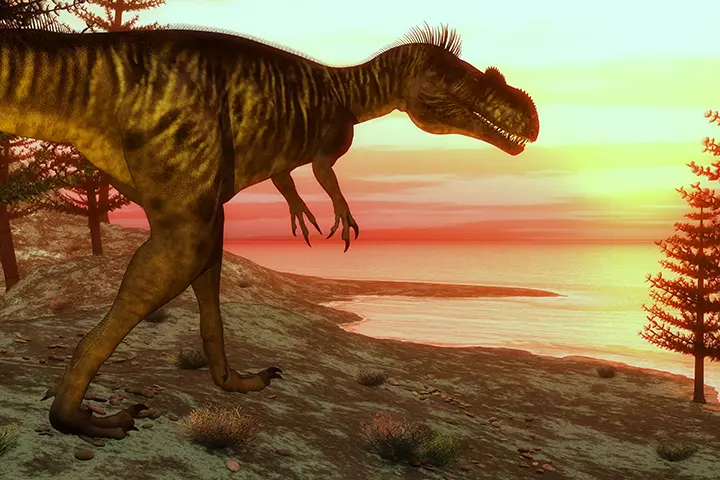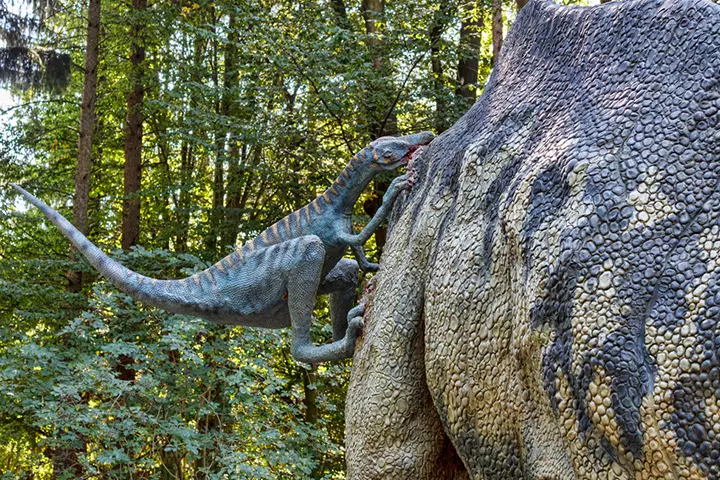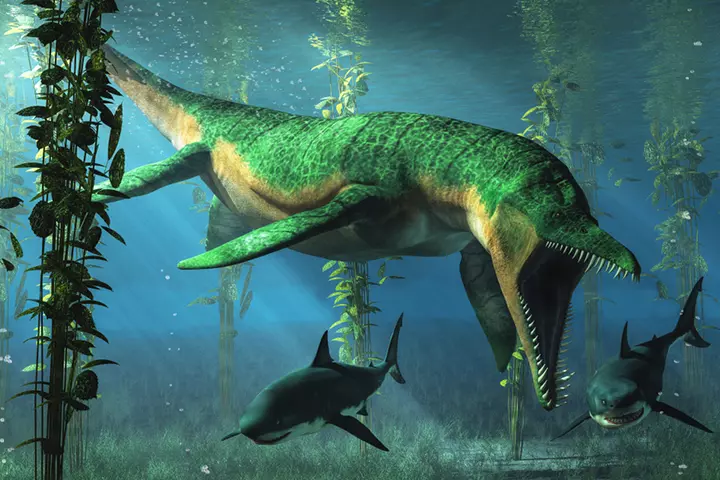
Image: Shutterstock
Dinosaurs roamed around the Earth for about 162 million years, i.e., millions of years before human beings arrived on the Earth. In this post, we bring many interesting facts about dinosaurs for kids. Dinosaurs lived in the Mesozoic EraiThe age of reptiles or dinosaurs that lasted around 66 to 252 million years ago. , divided into three periods: TriassiciFirst period of the mesozoic era that lasted until about 201 to 250 million years ago. , Jurassic, and Cretaceous periods. They were the dominant species of the animal world by the beginning of the JurassiciSecond period of the mesozoic era that lasted until about 140 to 190 million years ago. period, and then they became extinct about 66 million years ago. Your kids might be asking you questions like how many dinosaurs were there, what they were called, what happened to them, etc. Read this post as we bring fascinating information about the dinosaurs to keep your children entertained and engaged.

Key Pointers
- Dinosaurs look scary, but their evolution and extinction stories are intriguing for children across ages.
- Paleontologists and scientists have gathered several interesting facts about them that children will love.
- The Lost World, Age of Dinosaurs, and Land of The Lost are some of the many dinosaur movies that can entertain and engage children.
Origin Of The Word “Dinosaur” And What It Means?
Sir Richard Owen, a biologist from England, coined the term “dinosaur.” He used this word to classify a large group of animals, “Dinosauria” (1).
The word ’Dinosaur’ is derived from the Greek words “deinos,” which means “big and terrible,” and “sauros” meaning “lizard.” Although researchers called them “Big terrible lizards,” dinosaurs are not lizards.
Evolution Of A Dinosaur
Around 350 million years ago, due to natural phenomena, reptiles survived without water. As their bodies evolved, the reptiles changed to the four-legged amphibians. The early reptiles were lizards, snakes, turtles, ancestor mammals, and plesiosaursiA group of extinct long-necked marine reptiles belonging to the mesozoic era. . They were the prominent terrestrial reptiles throughout the Jurassic and Cretaceous periods, which fall within the Mesozoic period, also known as the Age of Reptiles (2).
It is believed that some of these reptiles later evolved into dinosaurs called “Archosaurs” and “AvemetatarsaliansiArchosaurs that are closely related to birds. .”
Types Of Dinosaurs
More than 700 dinosaur species have been discovered so far. Paleontologists hope to discover more species from the excavation sites. Megalosaurus, a giant carnivore, roamed the Earth about 169 million years ago. Megalosaurus was nine meters long and three meters tall. One of the first dinosaur fossils ever discovered was of the Megalosaurus. Reverend William Buckland, a geologist, was the first to study the fossil of a dinosaur in 1824. He named it Megalosaurus (3).
All dinosaurs descended from reptiles called ’Archosaurs.’ They came in different shapes and sizes. In 1887, British paleontologist Harry Seeley classified dinosaurs into Ornithischia and Saurischia based on their hip structure (4).
- Ornithischia: Also known as bird-hipped dinosaurs, Ornithischia were herbivorous. Ornithischia dinosaurs have no known carnivoresiAnimals that feed on the meat or flesh of other animals. within their group. They walked on all four legs. Triceratops, Iguanodon, and Stegosaurus were well-known dinosaurs from the Ornithischia category. Ornithischia dinosaurs were not precursors to birds.

- Saurischia: Also known as lizard-hipped dinosaurs, Saurischia were carnivores. They were the most feared and violent species that walked on two legs. They had short arms, sharp jaws, and powerful tails. The pubis boneiA bone situated in the pubic region that constitute the hip bone. in Saurischia dinosaurs, such as T-Rex, faced forward and down.
The top three Saurischian dinosaurs are T-Rex, Allosaurus, and Oviraptor. They were the precursor to the birds, which evolved from the avian dinosaur, who were the only ones to survive the extinction event.
Extinction Of Dinosaurs
For more than 165 million years, the dominance of dinosaurs was unchallenged except by other dinosaurs. But all that changed overnight when the dinosaurs were wiped out. The reason for their extinction is not known. However, the most accepted theory is that an asteroid strike that occurred 65 million years ago, at the end of the Cretaceous Period, led to their extinction (5).
Keep reading to know more about how the dinosaurs lived and thrived before nature struck them out.
 Trivia
TriviaInteresting Facts About Dinosaurs For Kids
- Paleontology is the study of fossils to understand the process of evolution. People who study paleontology are called paleontologists.
- Paleontologists studied the fossils and bones of dinosaurs and determined that they were several hundred million years old (6).
- Scientists discovered dino fossils in Antarctica too. However, there is no evidence suggesting that dinos lived there when Earth was a single landmass called Pangaea.
- Several dinosaurs, which were carnivores, had feathers and scales on their body.
- The Brachiosaurus and Apatosaurus were plant-eaters.
- The Triceratops was a fierce hunter with horns to defend itself against predators, while the Stegosaurus had spikes on their tail.
- Pterodactyls are not dinosaurs. They were flying reptiles that lived at the same age.
- Around 60% of the dinosaurs were herbivores (plant-eaters) and 40% were carnivores (meat-eaters) (2).
- Theropods dinosaurs are the ancestors of birds.
 Did you know?
Did you know?- British Paleontologist Richard Owen coined the word dinosaur in 1842.
- Spinosaurus was the largest carnivorous dinosaur. They lived on land and in water.
- Dinosaurs that looked like crocodiles existed in the CretaceousiA period of the mesozoic era that lasted until about 65 to 140 million years ago. Period (8).
- Before dinosaurs, reptiles existed on Earth. Archosaurs and Therapsids were the two reptile species to rule the Earth for millions of years.
- Apatosaurus, one of the largest dinosaurs, lived 300 years.
- Some dinosaurs had holes in their skull, which helped in absorbing moisture.
- Scientists hope to discover more dinosaur species.
- Megalosaurus was the first dinosaur to be named by humans.

- American geologist Ferdinand Vandeveer Hayden was the first person to discover dinosaur bones in North America.
- The Seismosaurus or ’earth-shaker’ reptile, is probably the longest dinosaur ever.
- Remains of dinosaurs have been discovered on all continents.
- The biggest dinosaur bone ever discovered was a part of the backbone of Argentinosaurus and measured 5x5ft.
- Micropachycephalosaurus is the longest dinosaur name. Fossil remains of this dinosaur were found in China.
- Carnivorous dinosaurs walked on two feet, which helped them run faster and hunt the prey.
- In 1923, Roy Chapman Andrews discovered the first dinosaur eggs in the Gobi Desert.
- Tyrannosaurus Rex had the longest teeth (8 inches).
- Herbivorous dinosaurs explored the grassy landscapes in herds for safety.
- A blue whale is bigger than any dinosaur.
- Carnivorous dinosaurs had bones filled with air.
- The smallest dinosaur skeletons ever found belonged to a baby Mussaurus or the “mouse lizard” (9).
- The smartest dinosaurs were the small carnivores.
- Herbivorous dinosaurs had eyes like humans. They had a 3D view of their surroundings, which helped them keep away from their enemies.
- A newly born human baby has a bigger brain compared to most adult dinosaurs. Dolphins and whales have the biggest brains amongst all living animals.
- Some herbivorous species also walked on two feet.

- Researchers believe dinosaurs must have shed their skin much like snakes and lizards.
- Theropods’ feet resembled that of birds.
- Due to mineral and calcium deposition in their bodies, several dinosaurs had colorful skin and amazing texture.
- T-Rex (Tyrannosaurus-Rex) had long black legs, but its front legs were shorter than human arms.
- The biggest dinosaur footprint ever discovered was 3 feet (1m) across and 4 feet long.
- Dinosaurs swallowed large rocks for digestion. Stones helped them grind the food better.
- T-Rex had a diet of approximately 22 tons of flesh in a year. It had eight-inch sharp teeth that let it chew hard meat chunks.
- Deinosuchus is an extinct relative of the crocodile. The “terrible crocodile,” Deinosuchus had the strongest bite, more powerful than the T-Rex.
- Corythosaurus used the hollow crest connected to their nose for creating echo-like sound.
Amazing Dinosaur Facts
- Longest Dinosaur: Argentinosaurus (40m height), which belonged to the Titanosaur group, is considered the longest dinosaur. Its fossils were discovered in Argentina.
- Heaviest Dinosaur: Argentinosaurus (weighed 77 tones) is also considered the heaviest, weighing as much as 17 African elephants put together. It is regarded as the largest land animal to have ever existed.
- Smallest Dinosaur: Lesothosaurus was a chicken-sized dinosaur.
- Intelligent Dinosaur: Troodon, a hunting dinosaur measuring about 2m long, had a brain similar to a mammal or bird of the 21st century.

- Smallest Dinosaur egg: Scientists discovered a 3cm long fossilized egg, the smallest dinosaur egg ever found.
- Tallest Dinosaur: The Brachiosaurid, a group of Sauropods, were the tallest dinosaurs. They had longer front legs compared to the rear legs that gave them a giraffe-like look. Their long necks helped them reach the tallest trees to feed on leaves. Sauroposeidon grew up to 18.5m tall!
- Fastest Running Dinosaur: Ornithomimids were the fastest dinosaurs. Dromiceiomimus, of the Ornithomimid genus, ran at a speed of 60 kilometers per hour.
- Oldest Dinosaur: The Nyasasaurus parringtoni is believed to be the oldest known dinosaur—it lived roughly 243 million years ago. Its remains were found in Tanzania only recently.
- Fiercest Dinosaur: Tyrannosaurus Rex was the most feared dinosaur. However, Utahraptor is the fiercest of all dinosaurs. Utahraptor stood 7m tall and was known to be powerful, agile, and cunning.
Strange Dinosaur Facts
- Herbivorous dinosaurs contributed to global warming by passing gas developed from undigested food.
- Sauropods were the tallest dinosaurs. They were two times taller than giraffes.
- Struthiomimus was a meat hunter that made screaming noises while attacking prey.
- T-Rex chased prey at a speed of 28 km/hr.
- Dinosaurs were heavy and couldn’t run faster than cheetahs.
- Dinosaurs that walked on two legs were called bipeds.
- The sound of the T-Rex’s footsteps in the movie Jurassic Park (1993) was recorded using the sequoiasiMassive trees that are known to reach about 300 feet in height. crashing the ground.
- Dinosaurs had their self-defense mechanisms. Carnivorous had shard teeth, herbivorous had long spikes or horns, and others had bony plates.
- Dinosaurs laid trillions of eggs in the Mesozoic era.
- Almost all dinosaurs laid eggs. Till today, around 40 kinds of eggs were discovered.
- Liopleurodon was the biggest aquatic reptile. It was half the size of the blue whale.

Movie Facts About Dinosaurs
- The first-ever dinosaur movie was called Prehistoric Peeps and was based on a comic. It was never released. The first dinosaur movie to release was Brute Force in 1914. Before that, a five-minute-long cartoon film called Gertie the Dinosaur was made.
- Jurassic Park, released in 1993, had only 15 minutes of dinosaur footage. The movie had six minutes of CGI and nine minutes of animatronics.
- Steven Spielberg’s movie on dinosaurs, ’Jurassic Park,’ was a well-researched movie on the subject.
- The scene from Jurassic Park, when T–Rex’s entry causes ripples in the water,is considered a classic even to this day
- Jurassic Park was shot between two locations – the Hawaiian island of Kaua’i, and Los Angeles in California.
 Trivia
TriviaBest Movies On Dinosaurs
Some dinosaur movies you could watch with your children are (10)
- Age of Dinosaurs
- Land of the Lost
- Ice Age: Dawn of the Dinosaurs
- King Kong
- Jurassic Park (All Parts)
- The Lost World
- Good Dinosaur
- 100 Million BC
- The Land Before Time
- Camosaur
Frequently Asked Questions
1. What can children learn from dinosaurs?
Introducing your children to the lives of dinosaurs can be a great way to teach them how creatures adapt, survive, and sometimes disappear from the environment. Teaching them that we do not know everything about the world yet and are still researching several aspects of nature and science may motivate them to do their own research.
2. Do dinosaurs sleep?
Yes, dinosaurs do sleep. The discovery of the fossil of a dinosaur resting with its head over the forearm and trunk and tail wrapped around its body proves that dinosaurs did sleep.
3. What were the different types of dinosaurs that existed?
Ornithischia and Saurischia are two main groups of dinosaurs based on their bone structures. Tyrannosaurus Rex, Seismosaurus, Mussaurus, Megalosaurus, Triceratops, Iguanodon, Stegosaurus, Allosaurus, Oviraptor, Brachiosaurus, and Spinosaurus were some of the dinosaurs falling under these categories.
4. What are the benefits of teaching kids about dinosaurs?
Teaching children about dinosaurs offers numerous benefits. For instance, learning about dinosaurs’ appearance, characteristics, and fossils can spark a child’s inquisitiveness about the natural world and boost their critical thinking. Knowing about theories of dinosaurs’ existence and extinction helps introduce children to fundamental scientific concepts such as geology, paleontology, anatomy, and evolution. Furthermore, learning about dinosaurs can help children learn about history and instill a lifelong passion for learning (11).
5. Is learning about dinosaurs a good way to introduce kids to science and nature?
Yes, dinosaurs provide an engaging way to introduce children to scientific concepts. Exploring various dinosaur species and learning theories about their evolution and extinction can help children understand the importance of biodiversity, conservation, and the impact of environmental changes on ecosystems (11).
6. What are the biggest misconceptions about dinosaurs that kids have?
Popular culture, media, and limited exposure to scientific information is the reason children can have several misconceptions about dinosaurs. For instance, children often think dinosaurs could fly. However, only a specific group of dinosaurs (pterosaurs) could fly. Similarly, children have the misconception that dinosaurs and humans lived together. However, humans lived almost 60 million years after the extinction of dinosaurs (12).
7. What age is appropriate for kids to start learning about dinosaurs?
Usually, children between two and four years old can develop an interest in learning about dinosaurs. So if your child shows interest in knowing about the origins, existence, and extinction of this marvelous creature, you can share age-appropriate, intriguing facts about dinosaurs from this post. You can also introduce them to dinosaur coloring pages so they can learn about different kinds of dinosaurs and what they looked like while developing their fine motor skills.
Mother and blogger Aisha Mahmoud writes in her blog about the time she took her son to the museum. She says, “I remember the first time I took him to a museum at the age of three. He began running towards a giant Triceratops, fell, got back up, and continued running with outreached arms… Three years later, my son’s love of dinosaurs has not faded. We’ve tried our hand at so many different hobbies, like creating dinosaur shaped soap, penning and illustrating dinosaur books, creating dinosaur models out of clay, painting dinosaur models, building dinosaurs, and the list continues (i)”
8. What are some of the best educational resources available to teach kids facts about dinosaurs?
Children can explore various online and offline resources to learn about dinosaurs (13). Educational documentaries and TV shows, in particular, can provide valuable insights about dinosaurs. They can read age-appropriate books on dinosaurs or visit websites like National Geographic Kids and BBC Earth, which provide interactive videos, quizzes, and articles tailored for children. In addition, you can take children to local museums and exhibitions that offer hands-on learning experiences.
9. How can learning about dinosaurs help children understand evolution?
Learning about dinosaurs can significantly enhance children’s understanding of evolution. For instance, examining different dinosaur species can help children know how certain features changed and evolved. Also, exploring the extinction of dinosaurs and the subsequent rise of new life forms can help children comprehend the biological concepts of natural selection and the survival of the fittest.
10. How can books and movies help kids learn about dinosaurs?
Visual representation in age-appropriate books and movies can teach children about the various dinosaurs, their names, unique characteristics, and behavior. In addition, they can provide children with interesting facts about dinosaurs through a compelling storytelling method and bolster their interest in additional learning activities like researching and reading.
11. How do I introduce dinosaurs to kindergarten?
To introduce dinosaurs to kindergarteners, start by reading a fun storybook with lots of pictures. Ask them questions about the story and the dinosaurs to get them involved. Make it even more interesting by singing songs or saying rhymes about dinosaurs. You can use puppet dinosaurs to show and tell interesting things about them. Let them get creative with dinosaur crafts for kids by making dinosaur masks, footprints, or paper plate dinosaurs. Play a game like a treasure hunt, where the children look for toy dinosaurs or bones. Use a box with sand and toy dinosaurs for an exciting sensory activity. Finally, have a discussion and share fascinating dinosaur facts, sparking curiosity and understanding.
These fascinating facts about dinosaurs for kids will keep your little ones hooked and pique their curiosity. This giant carnivore inhabited the earth around 169 million years ago, and so far, 700 different species of dinosaurs have been discovered. However, the existence of this creature was wiped out from the face of this planet overnight. These and other intriguing facts about dinosaurs will fill your kids with awe and may drive them to explore the subject more. You can feed their curiosity further by introducing them to our list of movies on dinosaurs.
Infographic: Exciting Dinosaur Facts For Children To Pique Their Curiosity
Dinosaurs have been among the most interesting subjects for children’s stories, movies, and cartoons. If your children are also intrigued by these magical-looking enormous creatures, keep this infographic on interesting dinosaur facts handy and share it with them. You can also print it and stick it to their bedroom wall.
Some thing wrong with infographic shortcode. please verify shortcode syntaxIllustration: Fun And Interesting Facts About Dinosaurs For Kids

Image: Stable Diffusion/MomJunction Design Team
Learn about dinosaurs with this fun and educational video! Discover amazing facts about these prehistoric creatures and get a lesson for kids.
Personal Experience: Source
MomJunction articles include first-hand experiences to provide you with better insights through real-life narratives. Here are the sources of personal accounts referenced in this article.
i. Dinosaur Mom, Dinosaur Fun.;https://medium.com/%40missghalia/dinosaur-mom-dinosaur-fun-25ba34a7b8d1
References
- Emily Osterloff Dinosauria: how the ’terrible lizards’ got their name
https://www.nhm.ac.uk/discover/how-dinosaurs-got-their-name.html - DINOSAURS. University of Cincinnati
https://www.uc.edu/content/dam/refresh/cont-ed-62/olli/dinosaurs.pdf - American Dinosaurs: Who and What Was First; American Scientist
https://www.americanscientist.org/article/american-dinosaurs-who-and-what-was-first# - The Classification of Dinosaurs; Forsyth Astronomical Society
https://www.fas37.org/wp/the-classification-of-dinosaurs/ - When did dinosaurs become extinct?; US Geological Survey
https://www.usgs.gov/faqs/when-did-dinosaurs-become-extinct - Dinosaur; American Museum of Natural History.
https://www.amnh.org/dinosaurs/dinosaur-facts#:~:text=Basic%20Dinosaur%20Facts&text=Dinosaur%20fossils%20have%20been%20found - Molecular analysis confirms T. Rex’s evolutionary link to birds; The Harvard Gazette
https://news.harvard.edu/gazette/story/2008/04/molecular-analysis-confirms-t-rexs-evolutionary-link-to-birds/ - The Cretaceous Period; Berkeley.edu.
https://ucmp.berkeley.edu/mesozoic/cretaceous/cretaceous.php - What was the biggest dinosaur? What was the smallest?; USGS
https://pubs.usgs.gov/gip/dinosaurs/ - Dinosaur Movies; Commonsense media
https://www.commonsensemedia.org/lists/dinosaur-movies - Why dinosaurs are a great tool for teaching in the early years; Community Early Learning Australia (CELA)
https://www.cela.org.au/publications/amplify!-blog/dec-2025/why-dinosaurs-are-great - Dinosaur Videos: 12 dinosaur myths that will blow your mind; University of Alberta Faculty of Science
http://www.ualberta.ca/en/science/dinosaurs/myths.html - Dinosaurs and Paleontology: A Resource Guide; Library of Congress
https://guides.loc.gov/dinosaurs/online-resources
Community Experiences
Join the conversation and become a part of our nurturing community! Share your stories, experiences, and insights to connect with fellow parents.
Read full bio of Catherine Mok
Read full bio of Nisha Bharatan
Read full bio of Harshita Makvana
Read full bio of Kavita Kankani

















